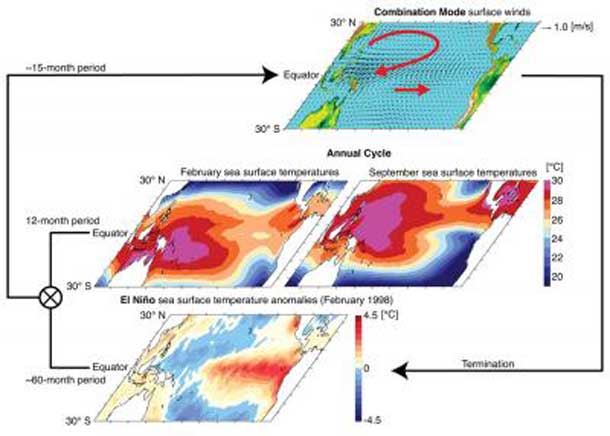
The ability to predict an El Nino at least a year ahead could help threatened countries better prepare for impacts, from flooding to drought
By Megan Rowling
BARCELONA – (Thomson Reuters Foundation) – The complex El Nino weather pattern that can bring disastrous heavy rainfall and long droughts to countries around the Pacific – from Peru to Indonesia and Australia – will probably emerge again in 2020, researchers have predicted.
An international team of scientists forecast an 80% chance next year of an El Nino, which occurs when sea-surface temperatures rise substantially above normal in the east-central Equatorial Pacific.
This week they said their model – which uses an algorithm that draws on analysis of links between changing air temperatures at a network of grid points across the Pacific region – could predict an El Nino at least a year ahead.
“Conventional methods are unable to make a reliable ‘El Nino’ forecast more than six months in advance. With our method, we have roughly doubled the previous warning time,” said co-developer Armin Bunde, a physicist at Germany’s Justus Liebig University Giessen.
The term El Nino, meaning “boy child” in Spanish, was first used in the 19th century by fishermen in Peru and Ecuador to refer to the unusually warm waters that reduced their catch just before Christmas, according to the World Meteorological Organization (WMO).
The phenomenon occurs every two to seven years and typically lasts for 9 to 12 months, often beginning mid-year and peaking between November and January.
Hans Joachim Schellnhuber, director emeritus of the Potsdam Institute for Climate Impact Research (PIK), said insights from the new method – which has been tested over the past few years – would be made available to people affected by El Nino.
PIK researcher Josef Ludescher said he would soon discuss the findings with the weather service in Peru.
El Nino often brings torrential rains in the north of the mountainous Latin American nation, with a high risk of mudslides, he said.
El Nino also can cause extended droughts in other parts of South America, Indonesia, Australia, and Africa, PIK said.
In the Indian subcontinent, it may change monsoon patterns, while California can experience more precipitation.
The new prediction method could give more time for authorities to prepare for such impacts, Ludescher added.
The team is now adapting the algorithm to be able to predict the timing and strength of El Nino. In the future, a similar method could be used to improve forecasts of Asia’s monsoon, he told the Thomson Reuters Foundation.
The discovery of the new method was first published in 2013 in the Proceedings of the National Academy of Sciences journal – and the scientists have since been checking its accuracy.
They said this week it correctly predicted the onset of the large El Nino that started in 2014 and ended in 2016 and the most recent event in 2018, as well as absences in other years.
The next expected El Nino, due to peak in late 2020, could push global average annual temperature rise to a new record in 2021, the researchers said.
Air temperature rise lags Pacific warming by about three months, they noted.
According to the WMO, 2016 became the warmest year on record because of the powerful El Nino in 2015-2016, combined with long-term climate change.
(Reporting by Megan Rowling @meganrowling; editing by Laurie Goering. Credit: Thomson Reuters Foundation)






